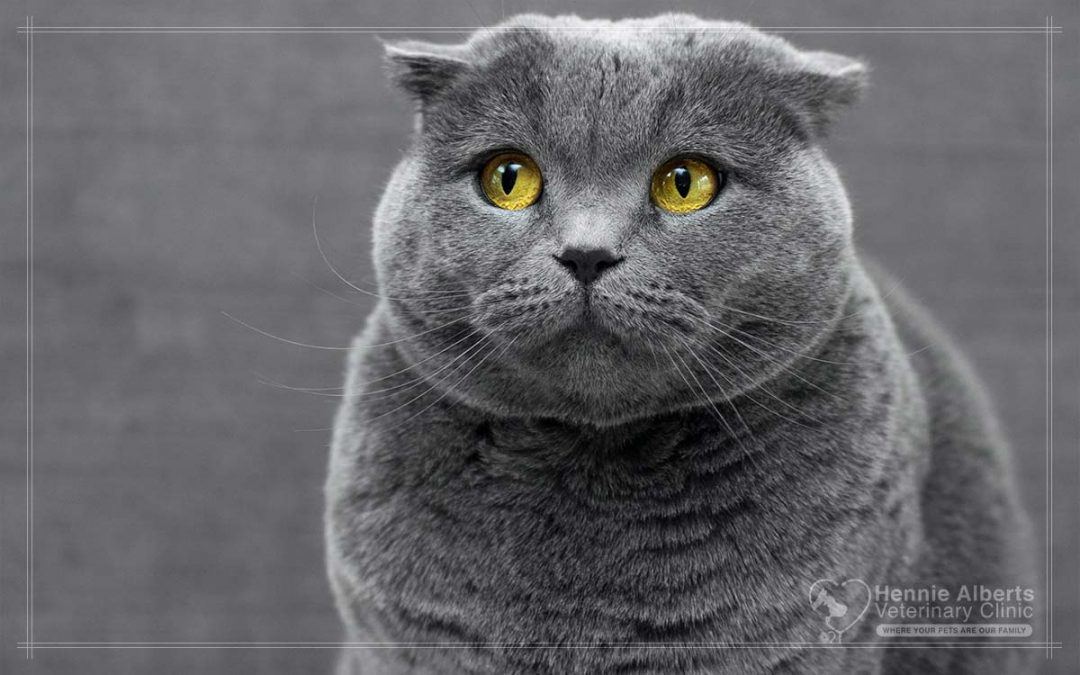Diabetes, a common condition for humans, is also relatively common in domestic animals. Diabetes mellitus is a disease in which the body doesn’t produce insulin (Type I or insulin dependent) or from the liver not responding to the insulin that is being produced (Type II or insulin resistant). Both conditions will prevent the muscles and organs from converting glucose to energy and will result in excessive amounts of glucose in the blood. Affected animals are dependent on daily insulin injections for maintaining blood sugar.
Type 1 is the most commonly-diagnosed type of diabetes in dogs, whereas Type 2 is the most common type diagnosed in cats. In dogs, Type 1 diabetes can occur at any age. Type 2 diabetes is seen more frequently in older, obese dogs, though it can also occur at any age. Indoor, middle-aged, obese cats are most likely to develop diabetes, but it can also happen to any cat at almost any age.
Insulin is a hormone that is produced in the pancreas and released into the cells in response to the digestive conversion of carbohydrates and protein into glucose in the bloodstream. Much of the food that is ingested is broken down into glucose, a type of sugar in the blood and one of the body’s main sources of energy. Appropriate insulin function will trigger the liver and muscles to take up glucose from the blood cells, converting it to energy.
An affected animal will be hungry a lot of the time. Since glucose is not making it to the brain, glucose levels in the brain are too low for the brain to register that it is receiving food. Because insulin is not giving the muscles and organs the signal to convert glucose to energy, the excess glucose in the blood will be carried out of the body in urine instead of being used for energy and there will be a concurrent lack of energy. The glucose ends up in the urine, where it interferes with normal urine concentration and leads to an increase in urination. The pet becomes dehydrated as a result of the abnormal water loss, so there is also increased thirst. The liver is adversely affected by this condition, as are the eyes and kidneys. Affected pets are also at increased risk for systemic infections, dental disease, and cataracts.
Early symptoms of diabetes in pets include excessive urination, excessive thirst, hunger, weight loss even with normal appetite, elevated blood glucose, and glucose in the urine.
Later symptoms include complete loss of appetite, lethargy and depression, vomiting, cataracts, worsening weight loss, and recurrent infections.
Sometimes, a cat will stand and walk with his hocks touching or nearly touching the ground. Instead of walking only on his paws, it would look like his whole foot is touching the ground. This is a form of diabetic neuropathy.
A life-threatening complication of unregulated diabetes is diabetic ketoacidosis (DKA) which is a metabolic acidosis caused by the breakdown in the liver of fat to ketones in response to starvation.
Genetic predisposition is one likely cause, as some breeds seem to be predisposed to diabetes, and dogs that have diabetes may also have affected relatives. Some medical conditions predispose a dog to developing diabetes. The conditions most commonly associated with diabetes are Cushings, pancreatitis, and obesity.
Feeding your cat too much fatty human food can cause inflammation of the pancreas—where you find insulin-producing cells—which can prevent insulin production. Prolonged use of steroids can also predispose a cat to diabetes.
With diabetes, an unusually high concentration of glucose will be found in the blood (the normal blood reading is between 3.3 and 6.6 mmol/l) as well as glucose being present in the urine.
The treatment almost always requires twice daily insulin injections combined with diet and weight management. There are many scientific veterinary diets on the market (such as Hills W/D and Royal Canin Diabetic) specifically made for diabetic animals. These diets have reduced fat, high fibre, and are clinically proven to help manage dogs with diabetes mellitus and help obesity-prone dogs to maintain optimum body weight.
Management of newly diagnosed diabetes can be challenging at first as it often requires regular blood glucose checks and adjustments, but with adequate attention and support many owners quickly adjust to the new routine.
After your pet has been on insulin for two weeks, a glucose curve is performed. This is a series of glucose measurements taken over the course of a day to determine if the starting dose is correct for that specific patient (the highest and lowest the glucose goes) as well as how long it is lasting. Adjustments will be made according to the curve.
Unfortunately, this is not a curable disease, but your pet’s health can be kept stable and it can go on to live a fully enjoyable life provided you follow your vet’s recommendations. If properly managed, diabetic patients can live a long and healthy life. Cats, however, sometimes revert to normal and may not need lifelong therapy. This too will depend on an owner’s commitment to management and weight control.

IMAGE COURTESY OF VETSULIN

